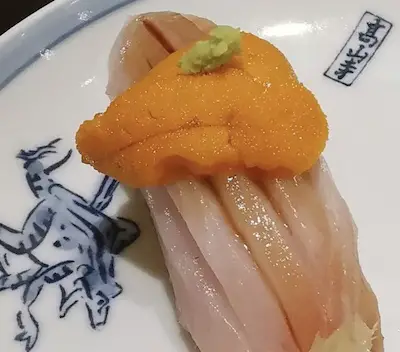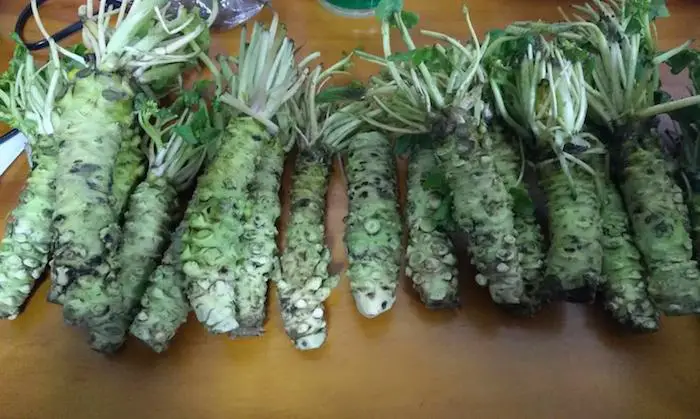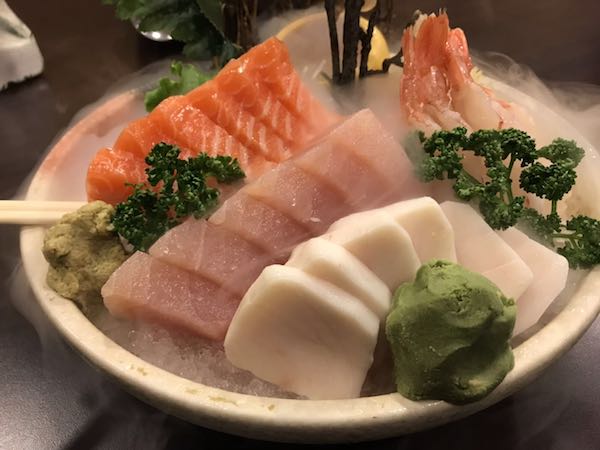We are reader supported. When you purchase through links on our site, we may earn an affiliate commission. Also, as an Amazon affiliate, we earn from qualifying purchases.

Wasabi may look like a humble and seemingly harmless green-colored side condiment on your sushi plate. It is one of the three most common things served with sushi – wasabi, soy sauce, and pickled ginger. However, it has a very bold character that can make you cringe and blow up your sinuses.
So, why do you eat wasabi with sushi? It adds a heat punch to raw fish to subdue the smell and pull out the delicate flavors more prominently. It also acts as an anti-bacterial to suppress the impact of microbes or bacteria that may be present.
The tradition of eating wasabi with sushi probably originated during the time when advanced technology was not available to preserve raw fish. Hence, people used alternative methods to prevent the risk of parasites and wasabi was one of them.
With the innovative freezing and storing techniques available in the modern age, wasabi is no more a ‘necessity’ to destroy parasites. However, it is still paired up with sushi as a habit and also because it enhances the flavor of the dish.
Contents
Sushi And Wasabi: An Iconic Culinary Pair!
If you are a sushi beginner, please be aware that the chef already applies a smear of wasabi between the bed of sushi rice and fish in nigirizushi. When making sushi rolls, he may brush a little wasabi over the rice, just where the fillings are arranged.
So, there’s already a bit of wasabi pre-applied to the dish. If you are fond of extra heat punch, just add a small blotch on your sushi before consuming it. That gives you two applications of wasabi on your sushi and that is more than enough. Anything beyond that will make your nose and eyes water like crazy!
Spare your tastebuds and don’t overdo the wasabi. The chef uses just the right amount of the green paste depending on how robust or delicate the flavor of raw fish is. Thus, wasabi and sushi make an inseparable pair in Japanese cuisine but it should be consumed properly.
A common mistake of eating wasabi is to mix it with soy sauce and if you are dining at a sushi restaurant in the US, you will probably see some diners do that! Please abstain from that habit because it’s not only against the sushi etiquettes but you will also spoil your chances of being served the best fish.
The Best-Kept Wasabi Secret Is Out!
Yes, I will tell you a secret here. A Japanese chef once admitted that there can bad consequences of mixing soy sauce with wasabi. When the chef sees a customer do that hideous thing, they stop servings their best fish to him. The customer is still served sushi-grade fish but not the best cuts because all that spiciness on his plate will hardly let him feel the difference in flavors.
The finest cuts are saved for customers who care about the quality of raw fish and do not create a mess of wasabi and sauces. A good chef will already add a little wasabi while preparing the dish. He may use a little or more depending on the type of fish he uses. Any more of the green paste will end up subduing the delicate flavors.
Pro tip:
When you sit at the bar, see how the chef prepares your food and you will know that he already adds wasabi to it. Tell the chef that you do not wish to add any extra wasabi or sauce to the dish he serves you.
The chef will gladly put an additional glaze of wasabi and soy sauce over the sushi with some garnish so that you straight away put it into your mouth. Trust me, friends, this is the best way to enjoy your sushi!
Real Wasabi Is Unknown To Most Sushi Fans
Given the fact that wasabi is such as popular condiment paired with sushi, it comes as a surprise that most sushi fans have no idea what real wasabi tastes like. The green stuff you get in the sushi restaurants is just a cheap substitute made by mixing horseradish, mustard and green food coloring. It is harsh, spicy, and not so fresh-tasting.
Even in Japan, real wasabi comes with such a high price tag that restaurants prefer to use the horseradish paste with a little or no real wasabi in it. The wasabi powder, paste, and canned forms that you get at the grocery stores are all lies that have been accepted over the years.
Real wasabi paste comes from grating the rhizome of a plant called Wasabia Japonica. It has a more herbal tinge than the fake horseradish stuff. While the real wasabi is hot, it does not leave you with a burning or lingering aftertaste. It is much smoother and cleaner than its substitute.
I have created an article that explains what wasabi is made of and the difference between real and fake wasabi. Check it out here.
12 Lesser Known Facts About Wasabi
#1. As per the Japanese folklore, wasabi was discovered centuries ago in a mountainous region by a farmer who decided to cultivate the plant. He later showed it to the warlord of the time and he decided it to be grown as a treasure only in Shizuoka area.
#2. Archeological excavations and historical records have proved that the Japanese used wasabi as a part of their food since the Jomon period that dates back to 400 BC.
#3. The mention of ‘wasabi’ can be found in the ancient Japanese encyclopedia of medicinal plants called the Honzo Wamyo. It reveals that wasabi was known for its medicinal properties at that time.
#4. Many historians believe that the commercial production of wasabi took place in the early Edo period (1603 to 1868). This probably has something to do with the rising popularity of sushi around that time.
#5. The wave of wasabi is believed to have reached the shores of the English-speaking countries with the growth of sushi restaurants around the 1980s.
#6. The wasabi plant requires special conditions to grow – cold mountain streams, abundant water, and no direct sunshine. It is difficult to grow and is mostly cultivated in the natural stream beds in mountainous regions.
#7. Wasabi is a perennial plant with brownish-green rhizome and large edible leaves that crown the plant, which can grow up to 46 centimeters in height.
#8. As the wasabi plant is hard to grow on a commercial scale, it is one of the most expensive crops in the world. Real wasabi stem costs about 160 per kilogram.

#9. Real wasabi loses its distinct flavor within 15 minutes if left out. As a result, some of the high-end sushi restaurants that serve the real thing will prepare the paste instantly when the customer orders.
#10. As there’s a very high demand for wasabi in Japan, they import a large quantity from South Korea, Israel, Thailand, Taiwan, and New Zealand.
#11. In the US, you can find real wasabi paste only in the specialty grocer’s or at the high-end restaurant. But, please be warned that they will come with a price.
#12. Inhaling the wasabi flavor has a similar effect like smelling salts, and this property is further explored by the Japanese researchers to create a fire alarm for those who are hearing-impaired.
See more: 6 Promising Health Benefits of Wasabi
Foods Paired With Wasabi (Other Than Sushi)
Now that you know why do you eat wasabi with sushi, you will be pleased to know that the green condiment also pairs up well with other foods. So, if you have some wasabi paste or powder lying in the fridge, you can use them to fire up these dishes.
1. Sashimi

Sashimi is the close cousin of sushi and some people often use the terms interchangeably to refer to the same thing. However, sushi is not the same as sashimi – they are two different dishes. While sushi comprises of raw fish with rice, vegetables, and nori, sashimi only comprises of precise cuts of raw fish often garnished with daikon radish.
Besides the raw fish used as a common element between these two delicacies, there are two more items that go with both and they are wasabi and soy sauce. It is customary in Japan to eat sashimi with wasabi and soy sauce. To bring out the best flavors of sashimi, a splotch of wasabi is placed over the fish slices.
Other than enhancing the flavor of the raw fish, many people believe that wasabi helps in preventing bacterial infection. So, you know it’s got a serious purpose there!
2. Roasted or grilled beef, steak
Roasted beef has a certain earthiness to it and the texture is pretty solid. To spice up the flavor and add a dash of heat, consider adding a blotch of wasabi paste to the steak. Those who love experimenting with the flavors will enjoy that distinct spiciness in the roasted meat.
To incorporate the taste of wasabi, marinade the beef with salt, sake, pepper, and wasabi paste. Preheat the grill, brush it with oil and let the steak cook thoroughly on both sides. Serve with steak sauces made of wasabi, soy sauce, and mirin.
You may also add a smear of wasabi paste in your hamburgers for that extra tang. Impress your guests with your culinary skills and keep them guessing!
3. Avocado
Yes, you read it right. The humble avocado can be spiced up with a little wasabi just like sashimi to bring out its fantastic flavors. Serve slices of avocado with wasabi and soy sauce for a refreshing appetizer. The tanginess of the wasabi perfectly complements the creamy taste of avocado to give you a delicious treat.
You may also use wasabi with vegetables like carrots, sweet potato, spinach, and broccoli to add a spicy kick to them. If you like tofu, dress it up with soy sauce, vinegar, salt, and wasabi for a soul-pleasing snack.
4. Tasty dipping and salad dressings
Apart from using it in different types of foods, you may also mix wasabi with different sauces and other items to make delicious dipping and dressings. For example, a mix of soy sauce, vinegar, wasabi, sugar, and oil make a tasty salad dressing.
Similarly, soy sauce, wasabi, and butter can come together to make a nice glaze for grilled pork or chicken. You can also purchase readymade wasabi sauces like this and dressings at any Asian grocery store or look for them online on Amazon.
5. Wasabi deviled eggs
You have probably heard of this popular southern appetizer, but you may not have heard about wasabi being incorporated into it. This classic dish is plain and boring, so add a dash of spice with wasabi. To make the filling, you will need 8 eggs, 1/3 cup mayo, 1.5 tsp wasabi, 2 tsp rice wine vinegar, salt, and finely chopped scallions for garnish.
Boil the 8 eggs, peel and cut them into half lengthwise. Transfer the yolks to a bowl and mash them with the above ingredients, except scallions. Fill the mixture into the whites and garnish with scallions. Serve.
6. Salmon with wasabi sauces
Give a fun twist to your dinner and impress your guests with this recipe. To cook salmon with wasabi, you will need half cup mirin, 2 tbsp soy sauce, ¼ cup rice vinegar, 1 tbsp grated ginger, salmon fillets, 1 tbsp lime juice, and 2 tsp wasabi powder.
Stir mirin, soy sauce, ginger, vinegar in a bowl and marinate the fish covered for about 10 minutes. In a pan, boil soy sauce, lime juice, and honey until it thickens. Mix wasabi powder in some water and add to the pan. Preheat a broiler and let the marinated fish cook for 5-6 minutes. Drizzle the sauce over the cooked fish.
Related Questions
Is wasabi used in sushi due to its medicinal properties?
The tradition of eating wasabi with sushi is believed to have started to combat parasites or bacterial infection from the uncooked meat. Wasabi is an anti-bacterial and anti-inflammatory compound that contains allyl isothiocyanate that can fight worms in food. Today, it is mostly used to enhance the flavor of your sushi dish.
What is the shelf life of wasabi?
The roots and rhizomes can last only for a month when stored properly inside the refrigerator. An unopened paste may last for 12 months but once opened, it starts losing its flavor very soon. If you have a wasabi root at home, keep an eye on it and trim off the rotten parts so that it stays good for long.
Why is wasabi considered as a versatile plant?
Besides the wasabi root which is rare and expensive, the leaves and stems of this plant are also used in different ways. They can be sautéed or pickled to be used as side dishes or appetizers. They can also be eaten raw as a salad.
What to do with the extra wasabi on your sushi plate?
Well, it’s a sad fact that you are always served extra wasabi with your sushi, even in the low-end restaurants. It’s not real wasabi anyway, so they don’t mind giving you more than you need. I would suggest you to just leave the extra wasabi on the plate without bothering to use it all because you will only end up spoiling your food.

